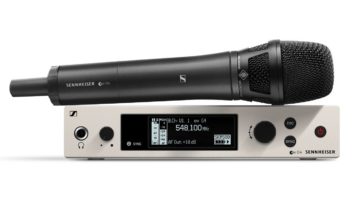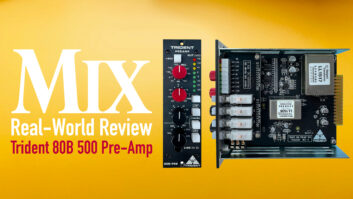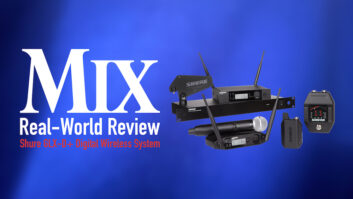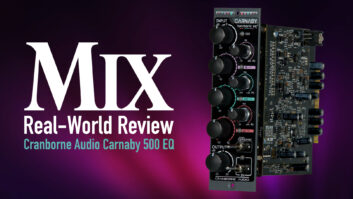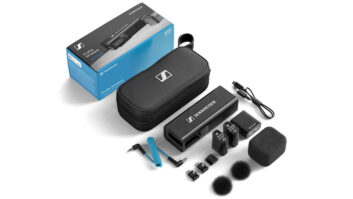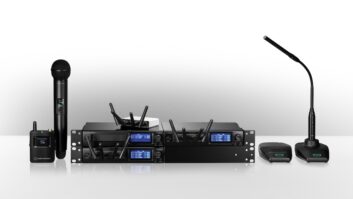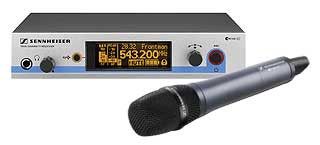
The ew 500 G3 includes Mac/PC management software, allowing for remote monitoring of many wireless Sennheiser products.
As wireless audio squeezes into reduced space due to the recent sale of bandwidth to Google, Verizon and others, RF audio equipment manufacturers are battling each other to push the limits of performance and features while keeping costs manageable. Sennheiser’s new ew 500 G3 Series of transmitters and receivers promises to deliver trouble-free RF operation and high-quality audio.
The system is available with two transmitters — a handheld mic (SKM 500 G3), which may be fitted with a variety of capsules, and a bodypack (SK 500 G3) that accommodates several different clip-on or head-worn mics — and the ci1 instrument cable. For this review, I received the ew 572 G3 B system with receiver, transmitter and instrument cable.
ew 500 G3 systems operate in one of six UHF frequency ranges between 516 and 865 MHz. Each range offers 26 banks with 32 channels per bank (maximum) and 1,680 possible transmission frequencies. Banks 1 through 20 feature factory presets configured to cooperate without intermodulation. The remaining six banks (U1 through U6) let you select and store any frequency, but it is up to you to choose these frequencies carefully to avoid interference with other wireless devices. When used in the U.S., the ew 500 G3 is not intended for operation in the 698 to 806MHz range in deference to recent FCC developments.
Rack It and Pack It
The EM 500 G3 receiver has rear panel jacks for two antennae (in true-diversity mode), XLR and ¼-inch audio output, and DC input for the included wall wart. Front panel controls include a headphone jack with volume knob, Sync button, jog dial, on/off/standby switch, backlit LCD and infrared interface. Via the jog dial, the unit’s LCD toggles between four main screens: Transmitter Parameters, Receiver Parameters, Soundcheck and Tuner. All four screens always display the receiver’s operating frequency, audio level, RF level at antenna I/II, battery strength and transmitter name (which you can enter). The Transmitter Parameters screen indicates transmitter model number, sensitivity setting, mic or line input, RF power level and cable emulation status. Receiver Parameters shows receiver output level, bank/channel, EQ curve and transmitter model. Change the screen to Soundcheck and the system enters a test mode in which you can walk the performance area while the EM 500 G3 monitors maximum and minimum RF levels. This proved helpful in previewing onstage reception for dropouts.
When you switch the receiver to Tuner, it activates a chromatic tuner that is very easy to read. You can set the tuner to automatically mute the output when in use.
The SK 500 G3 transmitter offers a small but serviceable LCD and runs on two AA batteries for approximately eight hours. External provisions include a threaded ⅛-inch jack for audio input, recessed mute switch, settings button and captive antenna. On/off and Set buttons are located under the battery cover to prevent accidents during a show. I liked having the on/off switch here but some of the musicians using the system did not. Transmitter adjustments include frequency, audio sensitivity, auto-lock-on/off, Mute mode, RF power output, cable emulation, pilot tone and LCD contrast. One LED on the pack indicates power on/off/low battery, while the other LED shows peak audio level. Frequency response of the system is spec’d as 25 to 18k Hz using the line input.
Hit the Road, Jack
The Receiver Parameters screen provides access to ew 500 G3’s Easy Setup mode. Scan New List scans the RF spectrum for unused channels and compiles a list of available channels. After setting the receiver frequency, you can open the belt pack to expose the infrared sensor, place the belt pack in front of the receiver and press the Sync button on the receiver. The receiver (via the infrared port) tells the transmitter to change to the appropriate channel — very clever. Of course, you can always manually set the frequency on both components.
When using the ew 500 G3 for guitar and bass, I encountered one snag: It was difficult to nail down unity gain settings. In theory, one sets the transmitter’s sensitivity just below clipping and then adjusts the output of the receiver so that gain structure of the guitar rig behaves as it would when using a cable. This was easier said than done. After a bit of fiddling, I settled on a sensitivity of -48 for the transmitter and +24 output from the receiver, but the gain staging of the guitar rig did not quite behave as it would if the guitar was connected via cable. (Perhaps in the future, Sennheiser can furnish “suggested” settings for guitar.) In any case, audio quality was excellent, and most people would be hard pressed to know the instrument was not tethered. Initially, I thought “cable emulation” was a simple high-cut filter, but careful listening revealed a subtle change in timbre, with a bit more “body” and a slight decrease in high frequencies as the emulation amount was increased.
The rear panel Ethernet port allows the ew 500 G3 to be used with Sennheiser’s Wireless System Manager (WSM) software, which — I am delighted to report — runs on Mac OS X and Windows. Available for free from Sennheiser’s Website, WSM is essential for multiple systems, but it’s useful even with only one system. In addition to the ew 500 G3, WSM allows for remote monitoring of many Sennheiser wireless products. On my MacBook, I could view RF strength, battery reserve, frequency and audio level, and the Properties menu addresses every system parameter.
WSM also provides RF spectrum analysis for pinpointing RF activity, as well as an RF level recorder that can log a time frame ranging from one minute to 24 hours. The purpose of the RF level recorder is similar to Soundcheck, but in WSM signal quality is shown on a graph depicting RF strength vs. time. You can walk the stage with the transmitter, and if there is an area where the signal is dropped, you can deploy a remote antenna to compensate. Embedded in WSM is Frequency Manager, an app that automatically scans the RF spectrum, finds vacant channels and allocates them to various wireless systems on the network.
Excellent Performer
Sennheiser’s ew 500 G3 succeeds on many levels. First and foremost, its audio quality is fabulous. Despite the fact that it employs companding, instruments never sounded like they were being dynamically altered, as I have found to be the case with lower-quality companding circuitry. RF performance is excellent. Throughout the shows I did not experience a single dropout or glitch, and all of the unit’s functions worked successfully. The management software works flawlessly and runs on OS X or Windows. Sennheiser has done a very thorough job in engineering the ew 500 G3, which should be on a shopping list for anyone considering a serious RF system.
Steve LaCerra is a live sound engineer based in New York City.

Click on the Product Summary box to view the product page
